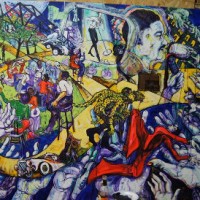Frizzi: Portrait of a Comedian
- Details
- Published on Monday, 23 June 2014 16:58
- Written by Donn Frizzi
“Heddy, you should see this painting!”
I had just returned to our table at the Recognize Richard fundraiser. It was held in May at Peoria’s Contemporary Art Center to raise money to bronze Preston Jackson’s incredible clay sculpture of Richard Pryor.
They had just brought out another Jackson masterpiece, a painting called “The Comedian.” It was based on the life of Pryor, beginning with his Peoria roots. It will be sold with proceeds going toward funding the bronzing of the sculpture.
Our table was directly behind that of Pryor’s son, Richard Jr. and his aunt. Richard Jr. was the guest performer that night, performing songs from his cabaret show. He doesn’t look much like his father, but his laughter and mannerisms were pure Pryor Senior.
I was on my way up for my second trip to the buffet table when I stopped to look at the painting. I’m nowhere near an art critic but I enjoy studying paintings and can draw a little bit, so here’s my take on “The Comedian.”
To me, the painting resembles the style of legendary album covers of the late ’60s and early ‘70s, when Pryor’s career really took off. It would make a perfect album cover for a compilation of Pryor’s Greatest Hits. The painting is movement on canvas. It is a vividly colored journey for the viewer to observe Pryor’s circle of life. But it seemed to take on a life of its own.
In the upper left hand corner, you’ll find famed local pianist Jimmy Binkley, a vet of the old Peoria juke joints, playing the keys. I imagined that Jimmy was performing the jazz soundtrack for this tour, just as he did when he played at Mr. Spencer’s night club in Pryor’s semi-biopic, “Jo Jo Dancer, Your Life is Calling.”
Just below Jimmy is a young boy sitting cross legged, intensely listening to an old man spinning yarns. The man’s name is Mudbone. To many, he looks like nothing more than a yammering old drunk. But, to the child, this man is a wealthy source of stories. Not just the stories themselves, but how they are told. The youngster studies the old timer intensely. He studies every gesture, dialect and movement of this old storefront storyteller much like one would study a sage. The old man didn’t know it and never would, but this kid would eventually take him onto a national stage.
To the right of Mudbone and his student we visit Hank’s Club and its patrons. Ghosts of former patrons hover over the bar. At the bar stands a sharp-dressed man. Seated next to him is a woman in red and dressed to kill. Both are outfitted to impress the opposite sex. Both watch the house band. Maybe later in the evening, they’ll get together and share notes. The bartender, arms crossed, surveys his domain from behind the bar while the bouncer stands guard, a pistol sticking out of his back pocket.
Meanwhile, Roz and her friend are sitting at a table watching a young, scrawny MC, skinnier than the mike stand and with a pompadour taller than he is, try out a few jokes before introducing the next act.
The next scene is a black and white television with the young, scrawny MC now on the national stage. The Comedian is on the nationally televised Ed Sullivan Show, the highest rated show on Sunday nights. And all Americans are watching The Comedian’s career take off like a rocket.
The focal point of the painting is of The Comedian on stage. He has learned his craft well. He has incorporated the teachings and mannerisms of Mudbone with the comedic art of other physical comedians, such as Jerry Lewis. But The Comedian has evolved, having quit his mainstream Vegas act and going into seclusion in Berkeley. He has come out more aware of his African-American roots and their subservient place in the American lifestyle. And he’s angry.
He tells you his stories and makes you laugh, because, after all, he is The Comedian. But he stalks the stage like a sleek African leopard. In the painting, you see both together, man and cat, as if they were one and the same. Both are proud and graceful and smooth as they stalk. They entertain you and make you laugh. Comedy is movement. It is physical. But I got the impression that the image might be of one great proud African soul, captured, caged and brought to America. This beast stalks back and forth in the cage at the zoo, entertaining the public that gawks at him. But without the barrier of the stage or the cage, the beast would like to pounce.
You then see the head of The Comedian. His face is aging over time. He clutches the microphone as if it were an extension of his own vocal cords. He needs the mike to speak, to express, to pass on the stories of Mudbone. The Comedian knows his time to entertain is growing short. Someday his hands will be physically unable to hold the mike and he will no longer be able to speak.
The Greek mask of tragedy is shown in the painting behind a car speeding out of control. But there is no mask of comedy. The Comedian knows, as all comedians do, that you cannot have comedy without tragedy. It’s the old story of “Grock the Clown.” A man tells his doctor that he is depressed and is contemplating suicide. The doctor suggests going to see a performance by “Grock the Clown,” the funniest man in the world. To which the man replies, “But Doctor, I AM Glock the Clown!”
A sinister Dickensian figure with greenish claw-like hands hovers over a hotel where silhouettes, involved in seamy activities, are shown in the windows at night. The sinister figure is a puppeteer. The puppet itself is sleek in red. Its wrists and legs are tied to cords and are manipulated by the sinister figure, like an addict’s addiction to crack cocaine. The drug controls the addict’s life like a puppet. In the beginning, the drug makes The Comedian so deliriously happy he can’t live without it. The Comedian is in pain. And after all, it’s better advice than what the doctor gave to Grock. The Comedian and all around him learn that when he takes the drug, he becomes a puppet, with and without it.
The painting is framed in wild scenes. A maniacal “Man In The Moon” is grinning fiendishly at the seamy activities of the night dwellers. Hands, looking more like grasping, clutching, covetous talons, creep out of every corner of the picture, trying to grasp a piece this poor soul’s fame, his money and his heart. The Comedian tries to his best to please. He attempts to make them laugh. He gives them everything he’s got on stage until he’s ready to collapse. And yet they still…just …got …to….have.…more.
This is what I saw in Preston Jackson’s painting.
I returned to our table, set down my plate of meatballs and cheeses and bread, nodded and smiled to Richard Jr. and his aunt as I took my wife up to look at this stunning work of art.
“Heddy, you should see this painting!”
I hope you get to see it, too.
Maybe one of you will buy it so we can get the rest of the cash to cast Preston Jackson’s statue of Richard Pryor. If you’d like to see it, contact Joy Kessler at joykessler44@gmail.com. It costs $7,500 and all proceeds go to the bronzing. True, $7, 500 isn’t cheap. But then, neither is bronzing a statue.
But if you do buy it, please donate the painting to the Peoria Riverfront Museum so the rest of us can enjoy it. That museum needs a lot more Richard Pryor in it.



















































